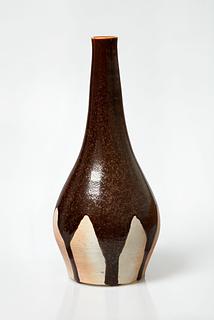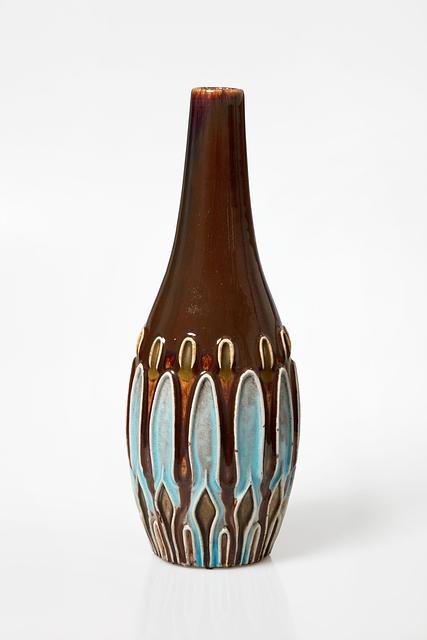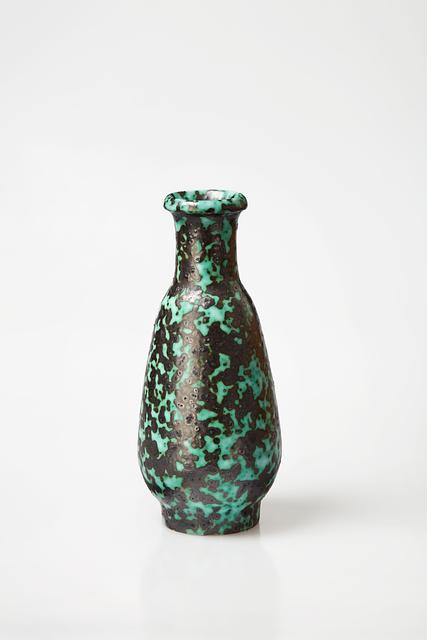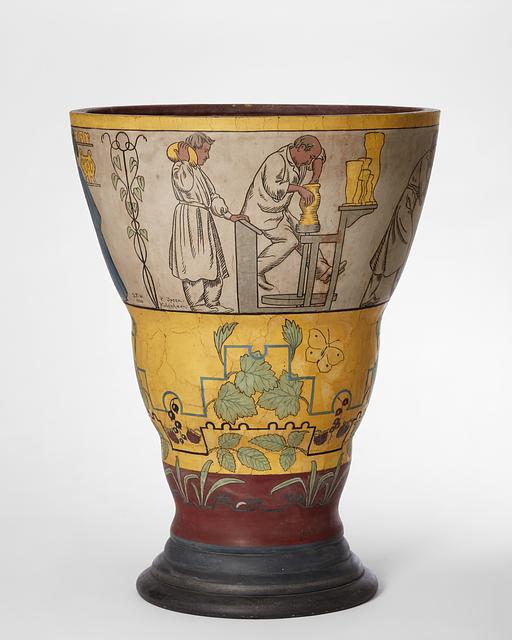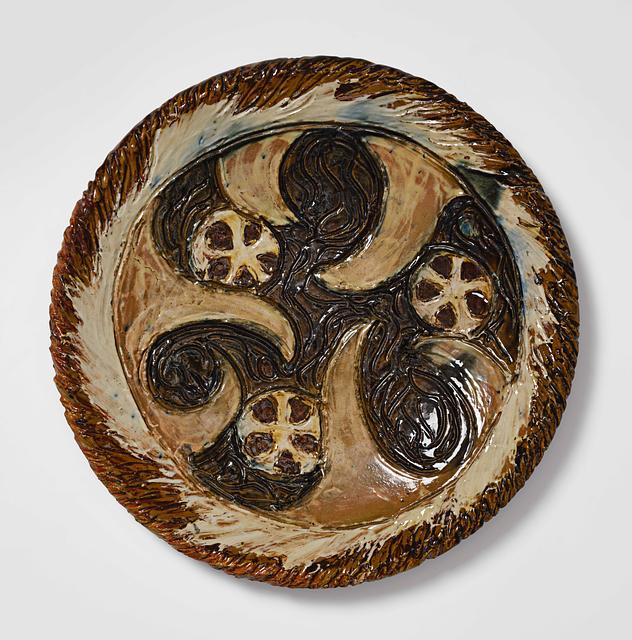Jens Ferdinand Willumsen (1863–1958)
Vase, 1897
Stoneware
H: 28 cm
Inventory number MK 67
During a stay in Paris in early 1891, J.F. Willumsen began modelling a sculpture, The Family Vase.1 While he had virtually no experience with ceramics beforehand, this sculpture became his first major work in clay and the beginning of a growing interest in working with ceramics.
In 1894 Willumsen left Paris and returned to Denmark, where he settled. He designed his own villa on Strandagervej in Hellerup, providing it with a studio and workshop, and from here there was access to a kiln house with a porcelain kiln, a muffle kiln and a smaller kiln for enamel.2 Here, in the years 1895 to 1898, he created a range of ceramic works of various kinds, including a large number of vases where he particularly devoted his attention to their glazes.
This slim-necked vase clearly shows how Willumsen has experimented with the glossy, brown drip glaze – which includes crushed bricks in its recipe – sliding down over the smooth, arched body and ending underneath the foot. The artist has utilised the unpredictability of the glaze as well as the uncontrollable nature of the process which the kiln itself invited him to explore. The fact that it is never possible to predict how the clay reacts during a firing undoubtedly appealed to Willumsen, who presumably did not create this vase with a mind to selling it.
The David Collection owns two more vases by Willumsen, MK 56 and MK 68. All three were acquired by C.L. David in the early 1950s.
In 1894 Willumsen left Paris and returned to Denmark, where he settled. He designed his own villa on Strandagervej in Hellerup, providing it with a studio and workshop, and from here there was access to a kiln house with a porcelain kiln, a muffle kiln and a smaller kiln for enamel.2 Here, in the years 1895 to 1898, he created a range of ceramic works of various kinds, including a large number of vases where he particularly devoted his attention to their glazes.
This slim-necked vase clearly shows how Willumsen has experimented with the glossy, brown drip glaze – which includes crushed bricks in its recipe – sliding down over the smooth, arched body and ending underneath the foot. The artist has utilised the unpredictability of the glaze as well as the uncontrollable nature of the process which the kiln itself invited him to explore. The fact that it is never possible to predict how the clay reacts during a firing undoubtedly appealed to Willumsen, who presumably did not create this vase with a mind to selling it.
The David Collection owns two more vases by Willumsen, MK 56 and MK 68. All three were acquired by C.L. David in the early 1950s.
Published in
Published in
Leila Krogh (ed.): Willumsens keramiske værker 1891-1900, J.F. Willumsens Museum, Frederikssund 1986, cat. 45, p. 78;
Leila Krogh in Kjeld von Folsach and Nana Lund (eds.): Dansk kunst i Davids Samling – fra Philipsen til Saxbo, København 1995, cat. 15, pp. 74-75;
Henrik Wivel: Jeg er en anden: en biografi om J.F. Willumsen, København 2024, Bd. 1, 1863-1914, fig. 98, p. 151;
Leila Krogh in Kjeld von Folsach and Nana Lund (eds.): Dansk kunst i Davids Samling – fra Philipsen til Saxbo, København 1995, cat. 15, pp. 74-75;
Henrik Wivel: Jeg er en anden: en biografi om J.F. Willumsen, København 2024, Bd. 1, 1863-1914, fig. 98, p. 151;
Footnotes
Footnotes
1.
Leila Krogh et al.: Willumsens keramiske værker 1891-1900, J.F. Willumsens Museum, Frederikssund 1986, p. 37.
2.
J.F. Willumsen, The Family Vase, 1891, Designmuseum Danmark, inv.no. 32/1956.
Ceramics
